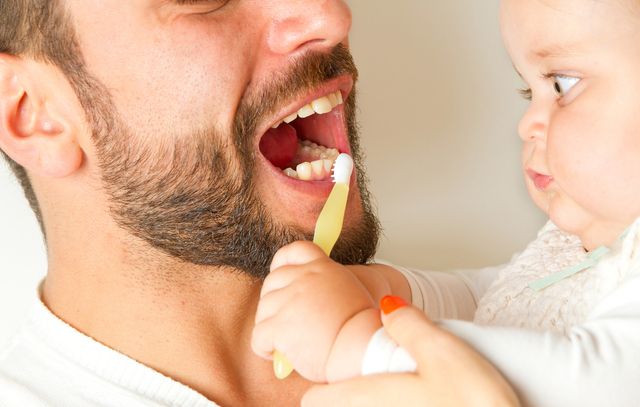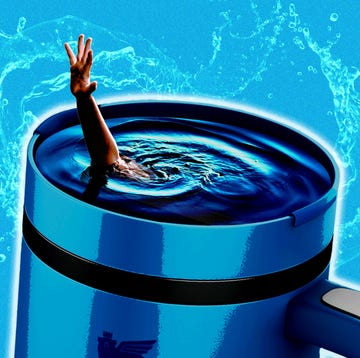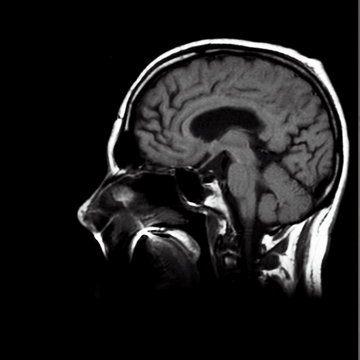You have two options when it comes to oral hygiene: Take good care of your teeth, or rock a stylish set of dentures.
You’re better off choosing option #1, since your life depends on it. Scientists have long said that the neglected bacteria that hang in your mouth may cause inflammation that affects other vital organs.
For example, new Swedish research finds that people with excess plaque are twice as likely to develop pancreatic cancer as those with cleaner teeth.
And in a study from Finland, people with the most dental tartar had double the risk of dying from heart failure.
Follow this dental plan to keep your mouth—and body—healthy for life.
PLAQUE
Run your tongue across your teeth. If they feel sticky or gritty instead of smooth, you might have a plaque problem.
Plaque is a combination of proteins from saliva, food, and bacteria that attach to your teeth, says Men’s Health dentistry advisor Mark S. Wolff, D.D.S., Ph.D.
Leave plaque alone and it becomes a breeding ground for bacteria that cause cavities, gingivitis, and bad breath.
Related: The Men’s Health Better Man Project—2,000+ Quick Tricks For Living Your Healthiest Life
Your Prevention Plan:
1. Buy an electric toothbrush.
Plaque is easy to remove if you find it early, so brush twice a day for 2 minutes each time, Dr. Wolff advises. Just use the right kind of brush: Electric models remove plaque 97 percent to 220 percent better than manual brushes, according to research in the American Journal of Dentistry.
Related: 6 Toothbrushing Mistakes You Make Every Morning
2. Floss.
People who floss every day have 11 percent less plaque in their mouths, says a study in the Journal of Periodontal Research. The problem: Only 5 percent of people floss correctly, German researchers say.
The key is matching floss to your teeth. “If you have rough fillings, use wax floss,” says Marjorie Jeffcoat, D.M.D., a Professor in the Department of Periodontics at the University of Pennsylvania.
If you have bigger spaces between your teeth, consider braided floss. Have average teeth? Use unwaxed floss; the friction will pull out more plaque, Dr. Jeffcoat says.
In terms of technique, listen as you slide the string. When it squeaks, you know the plaque is gone, she says.
CAVITIES
Cavities occur when plaque bacteria linger on your teeth for too long. One particularly bad bug, Streptococcus mutans, breaks down the food you eat into acids that penetrate your teeth and cause decay.
If you feel pain in a tooth or notice new sensitivity or holes, you likely have a cavity. Schedule an appointment with your dentist to fill it up.
Your Prevention Plan:
1. Use toothpaste with fluoride.
Every time you brush, you’ll deposit the material onto your teeth, protecting them from the wrath of acids, says Dr. Wolff. For extra insurance, swish with a mouthwash that contains fluoride.
Related: The Best Toothpastes for Men
2. Cut down on sugar.
Eating excess sweets causes the pH level of your saliva to plummet, transforming plaque into tooth-disolving acid.
You don’t have to cut out sugar entirely; Men’s Health nutrition advisor Alan Aragon, M.S., suggests shooting for a maximum of 10 percent of your daily calories to come from added sugars.
The more important play is learning how to time your sugar intake. As you eat dinner, the plaque on your teeth absorbs some of the fat, fiber, and protein of the food, filling up space that would otherwise be occupied by sugar.
So if that plaque is saturated with the food you just ate, the sugar you eat during dessert can’t sink in.
Same rule applies for any other time you’re sizing up sweets: Eat a little real food first and you’ll block out the sugar that follows.
3. Chew the right gum.
To satisfy your sweet tooth, chew gum with xylitol, a sugar substitute that helps reduce the bacteria that cause tooth decay, Dr. Wolff says. Research from Iran finds xyiltol gum keeps Streptococcus mutans from colonizing your mouth better than the regular kind.
Related: 9 Surprising Ways to Whiter Teeth
TARTAR
Tartar is another consequence of plaque left unattended. The hard film forms when naturally occurring minerals in your saliva, like calcium, deposit on plaque instead of your teeth.
The result is a hard, brownish-yellow deposit above your gum line that provides a home for even more bacteria. If you don’t see your dentist, the germs within your tartar can fester and cause gum recession and gum disease.
Your Prevention Plan:
1. Hit hot spots.
The biggest tartar buildup happens where your saliva ducts enter your mouth. But it’s hard to hit these spots—the backs of your lower front teeth and the outer sides of your top molars—with a full-size toothbrush.
Consider choosing a brush with a small head. And when you tackle the backs of your lower front teeth, turn the brush perpendicular to the floor, then scrub up and down.
ENAMEL EROSION
Every tooth is lined in a thin layer of enamel, which is mostly made of calcium and phosphate. When bacteria in plaque make acid, it wears down enamel.
Acidic foods also soften enamel and can dissolve it over time, Dr. Wolff says. There’s no way to restore enamel that’s washed away.
Your Prevention Plan:
1. Choose your drinks wisely.
Foods and drinks with a pH below 4 are considered erosive. In a recent University of Alabama study, every soda, energy drink, and sports drink that researchers tested came in below that pH level.
5-Hour Energy, Powerade, Coca Cola, and Pepsi were all found to be extremely erosive with pH levels under 3.
Related: 5 Things You Should Never Put in Your Mouth
Reserve sports drinks for truly tough workouts that make you sweat hard, Dr. Wolff says. Alternate sips with water to wash the acids away from your teeth.
If you need caffeine, drink regular black coffee, which is less erosive than bottled energy drinks.
2. Pair wine with cheese.
This helps neutralize acid on your teeth, Dr. Wolff says.
In fact, a study published in Nutrition Reviews examined the pH-boosting properties of 12 cheeses and found that aged cheddar, gouda, mozzarella, and Monterey Jack raised pH levels highest. And one bite is all you need; the study subjects ate less than a quarter ounce.
Additional reporting by Erin Hobday and Christa Sgobba













